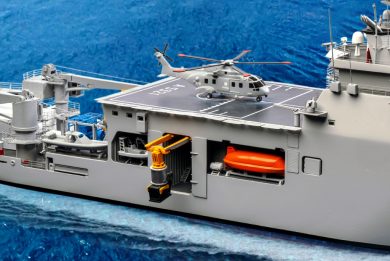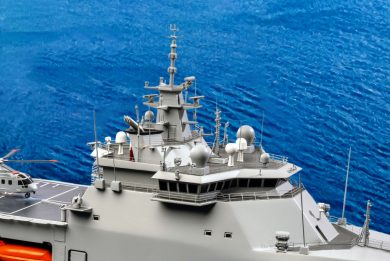The SDO-SURS platform highlights
Based on an Offshore Support Vessel (OSV) design, the SDO-SuRS was conceived by T. Mariotti shipyard with the support of the Italian Navy as a flexible, multi-purpose, reconfigurable ship, capable to carry out different missions. The main one is to independently conduct search, identification and rescue operations for the crew of a stricken submarine (Submarine Rescue Ship) with the new dedicated package developed by Drass with Italian industry. This is centred on the SAVER (Submarine Assistance, Ventilation and Rescue) Submarine Rescue Vehicle (SRV) element designed and provided by Drass and Saipem, for operations up to 600 metres depth. The ship can also embark other rescue systems available from allied navies, such as the NATO Submarine Rescue System (NSRS) and the US Navy’s Submarine Rescue Diving Recompression System (SRDRS).
Other missions include: support the Navy’s underwater activities and organized civilian underwater activities for the benefit of the community and the country’s interests; provide first aid and specialized medical care to civilian and military personnel suffering from underwater-related illnesses; serve as a Support Unit for Divers Operations Group (GOS, Gruppo Operativo Subacquei), part of Italian Navy’s Divers and Raiders Command (COMSUBIN); serve as a Support Unit for the underwater-amphibious operational-training activities of the COMSUBIN Special Forces (SF) Operations Group (Gruppo Operativo Incursori); support a deployable SFs Command on board.
With a length and beam of 128.5 metres (115.7 metres between perpendiculars) and 24 metres respectively, and a full load displacement of approximately 12,000 tonnes, the SDO-SuRS is characterised by a double hull, a design solution that meets the most stringent international pollution prevention and environmental protection rules which were certified by RINA (GREEN PLUS). The vessel was designed in RINA class as an offshore support vessel (diving support) with ‘unrestricted navigation’ capabilities and to comply with further class annotations of particular operational importance such as the ability to maintain the ship’s position in dynamic situations or International Maritime Organization (IMO) Dynamic Positioning Level 3 (DP 3) and the management of helicopter flight operations from the ship, in addition to those relating to personnel comfort in terms of noise and vibrations (COMF-NOISE-A and COMF-VIB-A).
The platform
The SDO-SuRS design is characterized by elevated superstructures extending from the bow to amidship, the aft section being at weather deck level to accommodate the SDO-SuRS mission packages. The forward ship area presents the main bridge superstructures accommodating the areas devoted to ship conduction and management, combat system, as well as crew and additional personnel – including SF operators – accommodations, hospital and an operational area for SFs missions. The main bridge has 360° visibility thanks to the two fully enclosed lateral protruding structures, and an area facing aft serving as the flight operations control centre and dynamic positioning system (DPS) control centre. The lower decks house the propulsion system control and ship’s combat operations centres, tactical operations and SF operations control centres. Capable of providing emergency treatment for personnel suffering from serious and moderate underwater illnesses, the embarked NATO Role 2B hospital includes an operating room, pre-operative and intensive care area with two beds, a five-bed ward, and outpatient clinics.
The SDO-SuRS can accommodate up to 80 crew members and 120 among GOS and GOI operators detachment in living and mess areas designed and equipped by Scorza, a GIN group company, together with the Italian Navy, to ensure maximum comfort. The amidship superstructure houses the elevated flight deck, those below being dedicated to the galley and additional crew accommodations, while lower ones house the “resident” or organic complex of equipment intended for the underwater activities by GOS operators. Measuring 30 x 24 metres and without hangar, the flight deck allows day and night operations of a Leonardo AW101 helicopter in sea conditions up to State 5.
Supporting underwater operations, the lower decks accommodate the centrally positioned 4 x 4 metres “moon pool” through the hull that allows the hauling and recovery of the diving bell, the related command and control station, the decompression chambers for the divers and related control centre, the stations intended respectively for the launch and recovery of the 9.35 metres operational RIHB and the 7.33 metres tender on the starboard side and those intended for the 10 metres hyperbaric lifeboat and the second 7.33 metres tender on the port side. Other two RIBHs (12 metres and 9.35 metres) can be accommodated in other ship stations. The starboard side also houses the hauling and recovery station for the Working Remotely Operated Vehicle (WROV), which supports both underwater and submarine rescue operations in case of need. These are complemented by the gas storage for saturation underwater operations, located under the main deck. To manage all activities, sensors, and ROVs/AUVs in the water, an Underwater Operations Centre (COS, Centro Operazioni Subacquee) known as Underwater Traffic Control (UTC) is located in the starboard aft corner of the amidship superstructures. With an opening on ship aft area, the latter also accommodates a storing hangar for the GOS/GOI on the main deck, where various mission-related materials can be recovered.
The aft ship area features a large working deck (40 x 22 metres) designed to accommodate three main equipment packages, depending on the mission. These include the suite for underwater operations, SF operations and the SAVER or other support and crew rescue systems. To better support these missions and equipment, the working deck is equipped with two Melcal offshore cranes, which are stabilized and capable of being used under sail. The main crane, positioned on the starboard side, has a maximum lifting capacity of 100 tonnes with a 15 metres outreach and can handle loads up to a depth of 3,000 meters, while the second crane, on the port side, has a maximum lifting capacity of 40 tonnes with a 15 metres outreach. The aft working area is served by a retractable ramp on the port side for loading materials and vehicles, while the extreme stern edge is lower to accommodate the hauling and recovery system for the submarine crew rescue system.
Graphics courtesy Mariotti Shipyard, photos by L. Peruzzi






